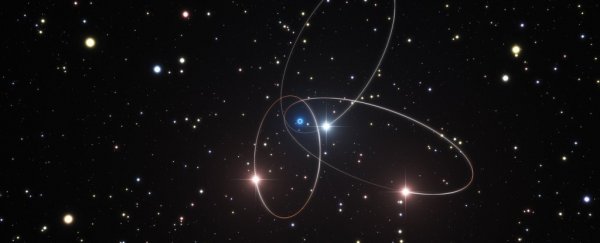In a few months, astronomers are going to be pointing their telescopes to Sagittarius A*, the supermassive black hole at the centre of our galaxy.
That's because it's going to be buzzed by a closely orbiting star - providing another context for testing Einstein's theory of general relativity.
The star is called S0-2, one of a class of stars known as S-stars (not to be confused with S-type stars) that closely orbit Sgr A*, which has an estimated mass of around 4.3 million Suns.
But S0-2 is special. It's one of two stars that zoom in closest to the black hole in its elliptical orbit, which means it's likely to show the effects of the black hole's gargantuan gravitational pull when it swings around once every 16 years.
According to general relativity, light affected by a strong gravitational field will get stretched out, or redshifted. The orbit will also shift, ever so slightly changing trajectory.
As S0-2 moves in for its closest approach at 17 light-hours away from the centre of the galaxy (about four times the distance between the Sun and Neptune), accelerating to 3 percent of the speed of light, researchers with the UCLA's Galactic Center Group will be carefully looking to see if these changes take place.
If they do, they'll have confirmed general relativity once again.
And now, thanks to a new study, we know that the redshift measurement can take place. There was a potential complication - what if S0-2 was a binary star, not one star, but two? This would complicate the upcoming measurements.
According to the study, wherein researchers conducted the first spectroscopic analysis on S0-2 as a potential binary, it is likely just one star, about 15 times the mass of the Sun. If it does have a companion, the companion is too small to have an effect on the planned observation.
"It will be the first measurement of its kind," said co-author Tuan Do, deputy director of the Galactic Center Group.
"Gravity is the least well-tested of the forces of nature. Einstein's theory has passed all other tests with flying colors so far, so if there are deviations measured, it would certainly raise lots of questions about the nature of gravity!"
S0-2 isn't just fascinating because it has implications for relativity - the entire cluster of S stars is peculiar.
They're quite young in star terms, which means they must have formed in the hostile environment close to Sgr A*, where the tidal forces of the black hole can tear star-forming regions apart - so just how they managed to form is still a mystery.
This could mean that there's another mechanism of star formation that we don't yet know about.
Researchers have been observing S0-2 since 1992, which means that its closest orbit has been observed before. In fact, it was used to constitute evidence for the existence of Sgr A* - but the instrumentation used wasn't sensitive enough to observe a gravitational redshift in the star's light.
But 16 years of refinements in the technology we use to study space have passed since then.
"We have been waiting 16 years for this," said lead author Devin Chu. "We are anxious to see how the star will behave under the black hole's violent pull. Will S0-2 follow Einstein's theory or will the star defy our current laws of physics? We will soon find out!"
S0-2 is due to pass Sgr A* around the middle of 2018.
Meanwhile, the team's paper detailing their analysis of the star can be found in The Astrophysical Journal.
